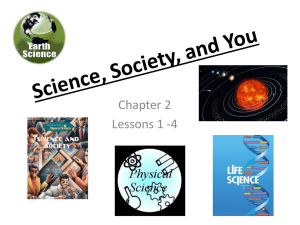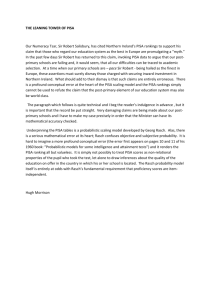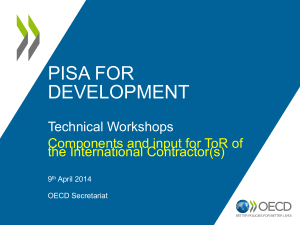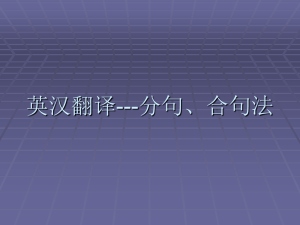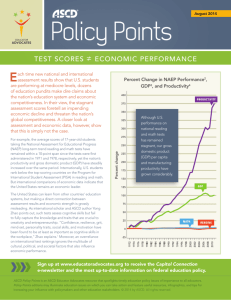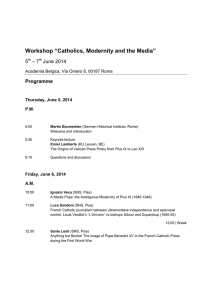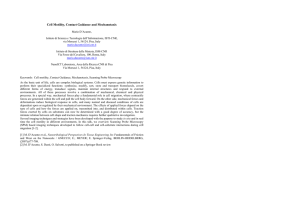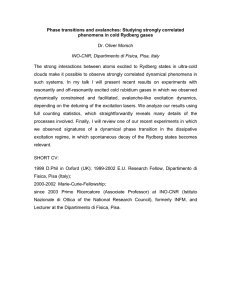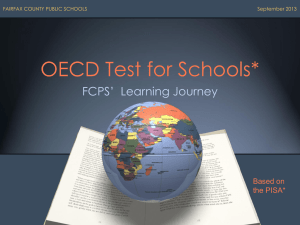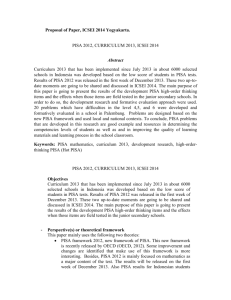PISA 2015 competencies (1) 科學地解釋現象Explain phenomena
advertisement
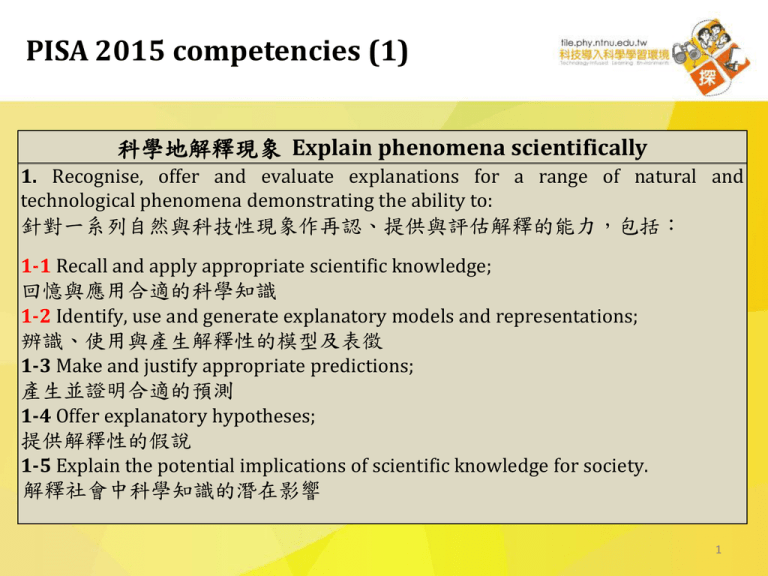
PISA 2015 competencies (1) 科學地解釋現象 Explain phenomena scientifically 1. Recognise, offer and evaluate explanations for a range of natural and technological phenomena demonstrating the ability to: 針對一系列自然與科技性現象作再認、提供與評估解釋的能力,包括: 1-1 Recall and apply appropriate scientific knowledge; 回憶與應用合適的科學知識 1-2 Identify, use and generate explanatory models and representations; 辨識、使用與產生解釋性的模型及表徵 1-3 Make and justify appropriate predictions; 產生並證明合適的預測 1-4 Offer explanatory hypotheses; 提供解釋性的假說 1-5 Explain the potential implications of scientific knowledge for society. 解釋社會中科學知識的潛在影響 1 PISA 2015 competencies (2) 評估與設計科學探究 活動 Evaluate and design scientific enquiry 2. Describe and appraise scientific investigations and propose ways of addressing questions scientifically demonstrating the ability to: 描述與評估科學調查活動,並提出可解決問題的科學方法,包括: 2-1 Identify the question explored in a given scientific study; 辨識出科學研究中所探索的問題 2-2 Distinguish questions that are possible to investigate scientifically; 區分出能進行科學調查的問題 2-3 Propose a way of exploring a given question scientifically; 提出一個能進行科學探索的方法 2-4 Evaluate ways of exploring a given question scientifically; 評估進行科學探索的方法 2-5 Describe and evaluate a range of ways that scientists use to ensure the reliability of data and the objectivity and generalisability of explanations. 敘述與評估一系列科學家用以確認資料的信度與解釋的客觀性和一般性之方法 2 PISA 2015 competencies (3) 科學地解釋數據與證據 data and evidence scientifically 3. Analyse and evaluate scientific data, claims and arguments in a variety of representations and draw appropriate conclusions demonstrating the ability to: 利用一系列表徵進行分析並評估科學數據、主張與論證,並產生合適推論的能力, 包括: 3-1 Transform data from one representation to another; 將數據作不同表徵的轉換 3-2 Analyse and interpret data and draw appropriate conclusions; 分析與解釋數據,並產生合適的推論 3-3 Identify the assumptions, evidence and reasoning in science-related texts; 在科學相關的文本中,辨識出假說、證據與推理 3-4 Distinguish between arguments which are based on scientific evidence and theory and those based on other considerations; 區分出以科學證據和理論為基礎的論證,或以其他考量因素為基礎的論證 3-5 Evaluate scientific arguments and evidence from different sources (e.g. newspaper, internet, journals). 透過不同來源(如:新聞、網路、期刊)評估科學論證與證據 3 PISA 2015 Knowledge of the Content (1) 物理所包含的內容 Physical Systems that require knowledge of Structure of matter (e.g., particle model, bonds) 物質結構(如:粒子模型、鍵結) Properties of matter (e.g., changes of state, thermal and electrical conductivity) 物質特性(如:狀態變化、導熱與導電性) Chemical changes of matter (e.g., chemical reactions, energy transfer, acids/bases) 物質的化學變化(如:化學反應、能量傳遞、酸/鹼) Motion and forces (e.g., velocity, friction) and action at a distance (e.g., magnetic, gravitational and electrostatic forces) 運動與力(如:速度、摩擦力)及與距離有關的活動(如:磁力、重力與靜電 力) Energy and its transformation (e.g., conservation, dissipation, chemical reactions) 能量與其傳遞(如:守恆、耗損、化學反應) Interactions between energy and matter (e.g., light and radio waves, sound and seismic waves) 能量與物質間的交互作用(如:光波與無線電波、聲波與地震波) 4 PISA 2015 Knowledge of the Content (2) 生物所包含的內容 Living Systems that require knowledge of Cells (e.g., structures and function, DNA, plant and animal) 細胞(如:結構與功能、DNA、植物與動物) The concept of an organism (e.g., unicellular and multicellular) 生物體的概念(如:單細胞與多細胞) Humans (e.g., health, nutrition, subsystems such as digestion, respiration, circulation, excretion, reproduction and their relationship) 人類(如:健康、營養,如消化、呼吸、循環、排泄、生殖等子系統及其之間 的關係) Populations (e.g., species, evolution, biodiversity, genetic variation) 人口(如:物種、進化、生物多樣性、遺傳變異) Ecosystems (e.g., food chains, matter and energy flow) 生態系統(如:食物鏈、物質與能量之轉流) Biosphere (e.g., ecosystem services, sustainability) 生物圈(如:生態系統服務、永續發展) 5 PISA 2015 Knowledge of the Content (3) 地科所包含的內容 Earth and Space Systems that require knowledge of Structures of the Earth systems (e.g., lithosphere, atmosphere, hydrosphere) 地球結構(如:岩石圈、大氣、水圈) Energy in the Earth systems (e.g., sources, global climate) 地球的能源(如:來源、全球氣候) Change in Earth systems (e.g., plate tectonics, geochemical cycles, constructive and destructive forces) 地球的改變(如:板塊構造、地球化學循環、建構性與破壞性力量) Earth’s history (e.g., fossils, origin and evolution) 地球的歷史(如:化石、起源與演化) Earth in space (e.g., gravity, solar systems, galaxies) 太空中的地球(如:重力、太陽系、星系) The history and scale of the Universe and its history (e.g., light year, Big Bang theory) 宇宙的歷史與規模(如:光年、大爆炸理論) 6 PISA 2015 Procedural Knowledge (1) 程序性知識 Procedural Knowledge The concept of variables including dependent, independent and control variables; 變因的概念,包含相依與獨立變因,以及控制變因 Concepts of measurement e.g., quantitative [measurements], qualitative [observations], the use of a scale, categorical and continuous variables; 測量的概念,如:量化(測量)、質性(觀察)、尺規的使用、類別與連續變項 Ways of assessing and minimising uncertainty such as repeating and averaging measurements; 測驗與減少不確定性的方法,如重複測量並取平均值 Mechanisms to ensure the replicability (closeness of agreement between repeated measures of the same quantity) and accuracy of data (the closeness of agreement between a measured quantity and a true value of the measure); 保可複製(重複測量之間的一致程度)與數據精確性(測量值與實際值間的一致 程度)之機制 7 PISA 2015 Procedural Knowledge (2) 程序性知識 Procedural Knowledge Common ways of abstracting and representing data using tables, graphs and charts and their appropriate use; 將數據抽象化或呈現的常用方法,如適當地使用表格、圖形、統計圖 The control of variables strategy and its role in experimental design or the use of randomised controlled trials to avoid confounded findings and identify possible causal mechanisms; 變因的控制策略及其在實驗設計中的角色,或利用隨機對照試驗,避免結果混淆 或找出可能的因果機制 The nature of an appropriate design for a given scientific question e.g., experimental, field based or pattern seeking. 設計一個合適的科學問題之本質,如:實驗、場域/範圍、尋找趨勢/模式 8
